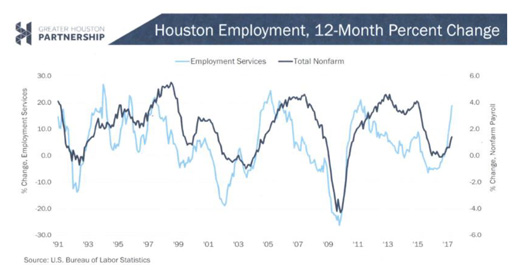 The following article originally appeared in the June newsletter to clients of Kiley Advisors, now a part of FMI Corporation, for the purpose of providing the latest leading indicators and industry issues to those clients. Reprinted with permission.
The following article originally appeared in the June newsletter to clients of Kiley Advisors, now a part of FMI Corporation, for the purpose of providing the latest leading indicators and industry issues to those clients. Reprinted with permission.
Recent employment numbers show Houston MSA added a surprisingly strong 18,700 jobs in April. Maybe too strong, according to Patrick Jankowski, vice president of research at the Greater Houston Partnership. The long-term average April job growth is around 8,000, and while early indicators, like employment services shown in the chart to the right, suggest Houston is recovering, Jankowski believes the April number will be revised down significantly, as 18,700 is stronger than what the city experienced when oil prices were at their highest. Reinforcing Jankowski’s reservations are the recent revisions to the 2016 numbers, which look to wipe away all the job growth last year, as well as the recent release of the Super Bowl impact numbers, which show sales tax revenues less than projected, possibly a sign that Houston’s economy was weaker than we realized.
Nevertheless, the Purchasing Managers Index jumped to 54.3, suggesting expansion in our area. And while the Architecture Billings Index is at a relatively flat 50.9, the southern region, where Texas is located, was significantly stronger at 55.3 – also suggesting expansion. The new project inquiries and new design contracts indices also posted strong numbers, with AIA Chief Economist Kermit Baker noting that the “new project activities [have] pushed up project backlogs at architecture firms to their highest level since the design market began its recovery earlier this decade.” Additionally, the United States Census Bureau recently announced the February and March total construction spending numbers, which were the first to exceed the previous high, set in February 2006. These indicators suggest that the rest of the nation is picking up speed, while Houston is growing at a more measured pace.
The primary drivers of our measured pace in construction continue to be the general purpose office space and multifamily markets, though hospitality is also waning and medical work may be hazier, given the activities in Washington, D.C. Office has dropped from its more than 17 million square feet to 1 million square feet, and multifamily, with 30,000 units still in lease-up, expects 14,000 units total to be delivered this year and 3,000-5,000 units for all of 2018 as the pipeline finally dries up. Keeping us afloat are the residential, educational and retail markets, which continue to catch up to the population growth experienced in Houston this decade. Homebuilders are targeting smaller lots with homes priced under $300,000 to reach the highest demand of homebuyers. The Grand Parkway, along with edge cities like Conroe, continue to grow at a significantly faster pace, driving school and retail demand.
Houston’s Monthly Metrics: June 2017
by Candace Hernandez | June 14, 2017


